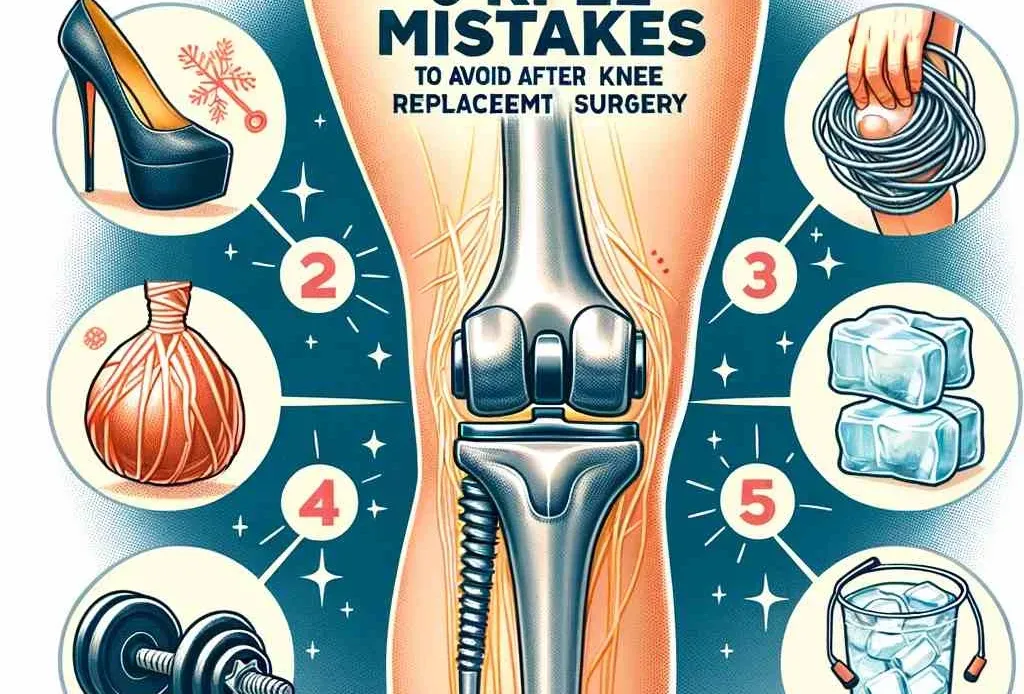Knee replacement surgery is a standard procedure that can help relieve severe pain and improve mobility in patients with severe arthritis or joint injury in the knee. Over 600,000 knee replacements are performed in the United States each year. While most patients experience excellent outcomes from the surgery, mistakes made during the recovery period can lead to complications. Avoiding these common Top 5 Mistakes After knee Replacement is crucial for ensuring a smooth recovery after knee replacement.
Introduction
Knee replacement surgery, also known as knee arthroplasty, involves removing damaged cartilage and bone from the knee joint and replacing them with a synthetic surface made of plastic and metal components. The procedure usually takes 1-2 hours to complete. Most patients stay in the hospital for 1-3 days after the procedure.
Full recovery from knee replacement surgery takes about 3-6 months. During this recovery period, it is essential to avoid inevitable mistakes that can impede progress. Following the doctor‘s instructions carefully during the postoperative period reduces the risk of complications. Physical therapy also plays a critical role in recovery.
While knee replacement surgery is highly successful in relieving pain and restoring mobility, recovery does require dedication and patience on the part of the patient. Awareness of the most common mistakes after knee replacement will help patients take the necessary precautions to protect the new joint and ensure the best outcome.
Mistake 1: Doing Too Much Too Soon

One of the biggest mistakes people make after Top 5 Mistakes After knee Replacement is pushing themselves to recover too quickly. It is important not to overdo activities in the first several weeks after surgery. Many patients are eager to get back to their regular routines. However, the knee needs adequate time to heal correctly after this significant procedure.
I made the mistake of trying to do too much around the house in the first couple of weeks after my knee replacement surgery. I ended up overworking my new knee joint, which caused increased swelling and pain. It set my recovery back by several days. I learned that it is crucial to take it very easy early on in the healing process.
In the hospital after surgery and during the first 2-4 weeks at home, patients should follow all restrictions provided by their surgeon. Activities are gradually increased over time under the guidance of a physical therapist. Pushing yourself too quickly can damage the surgical site before it has healed properly. This can lead to:
- Increased swelling and stiffness in the knee joint
- Bleeding into the new joint
- Dislocation of the knee replacement components
- Fracture or loosening of the components
- Infection
Trying to rush through rehab and progress too fast with exercise is one of the most significant mistakes patients can make after knee replacement. Taking the time to allow the soft tissues and bone to heal avoids unnecessary complications. Following activity limitations diligently early on helps ensure you can return to a higher level of functioning.
Mistake 2: Not Following Physical Therapy Instructions

One of the most vital components of recovery from knee replacement is physical therapy. Starting rehabilitation quickly and adhering to the program maximizes outcomes from surgery. Refrain from following material therapy recommendations after knee replacement surgery to ensure your progress is maintained.
My uncle had a knee replacement last year. He thought he knew better than his physical therapist and started trying to walk without crutches sooner than he was supposed to. He ended up falling and dislocating his new knee. Had to have additional surgery to repair the damage. Not listening to his physical therapist was a grave mistake.
Following prescribed exercises and activity guidance is essential during the rehabilitation process. Physical therapists design specialized programs to help patients regain range of motion and strength safely based on their condition. They proceed gradually to allow the body time to heal correctly.
Physical therapy after knee replacement surgery focuses on the following:
- Improving knee joint mobility and flexibility
- Reducing pain and swelling
- Strengthening the muscles around the knee
- Restoring normal gait pattern
- Improving stability and balance
- Teaching safe techniques for everyday activities
- Building patient confidence in the new joint
Some critical rehab components include range-of-motion exercises, stretching, muscle strengthening, balance training, assistive devices like crutches or walkers, and ice and heat therapy. Your physical therapist will progress your program appropriately as the reconstructed knee heals.
Proper rehabilitation relieves pain, prevents complications, and returns patients to daily life. Skipping physical therapy visits or not doing recommended exercises impedes recovery. Close collaboration with your physical therapist ensures the best functional results from knee replacement surgery.
Mistake 3: Not Taking Medications as Directed

Most patients experience significant pain following knee replacement surgery. Taking medications as prescribed helps manage pain and prevent complications during the recovery process. Not taking pain medications appropriately after surgery can hinder your progress.
My mother was stubborn about taking her pain pills after her knee replacement surgery. She wanted to tough it out and took way less than she was prescribed. Her pain never subsided enough to participate appropriately in physical therapy. She had a much longer, more complicated recovery than was necessary.
Your doctor will prescribe medications to control your pain and prevent infection after knee replacement surgery. Commonly prescribed medications include:
- Opioid pain medications like oxycodone, hydrocodone, or morphine. These should be taken for the first 1-2 weeks on a scheduled basis.
- Anti-inflammatory medications like ibuprofen or naproxen. These help reduce swelling and pain.
- Acetaminophen is a milder pain reliever.
- Antibiotics to prevent infection.
- Blood thinners to prevent clots.
- Stool softeners to ease constipation from other medications.
It is essential to follow the prescribed regimen closely, especially during the first month after surgery. Trying to ignore or under-treat pain often backfires and leads to worse outcomes. Taking medications as directed will aid wound healing, improve mobility, allow participation in physical therapy, and speed your recovery.
Mistake 4: Overusing or Not Using Assistive Devices Properly

Crutches, walkers, raised toilet seats, dressing aids, and other assistive devices are prescribed after knee replacement while the joint is healing and stabilizing. Using assistive devices protects your new knee, helps prevent falls, and improves safety during daily tasks. Errors in using these devices after surgery can undermine your progress.
In the hospital and rehabilitation facility, therapists teach patients how to use assistive devices correctly. But once patients get home, mistakes can happen, like putting too much weight on a walker or getting rid of crutches too early. These kinds of errors are easy to make but can be detrimental.
For example, my father ditched his crutches after just two weeks, thinking his knee felt good enough. However, his balance and strength were not yet where they needed to be. He ended up falling down the stairs and re-injuring his knee replacement.
To avoid errors with assistive devices:
- Use crutches or a walker for the full recommended time. This allows the knee to heal before full weight-bearing completely.
- Ask for help with stairs, dressing, and bathing until your therapist says you have enough strength and balance to do them safely alone.
- Maintain proper form – don’t lean or put too much weight on walkers or crutches.
- Watch for hazards like rugs, pets, or uneven pavement that could lead to falls.
Assistive devices must appropriately protect the healing knee and prevent dangerous falls. Make sure you understand how to use any prescribed device correctly. Ask questions if uncertain. Don’t progress to full weight-bearing until your doctor or physical therapist gives the all-clear.
Mistake 5: Not Maintaining Proper Nutrition and Hydration
Maintaining good nutrition and staying hydrated is vital during recovery from any surgery. Proper nutrients aid wound healing and support the immune system to prevent infection. Dehydration also slows recovery. Not eating right or drinking enough fluids after knee replacement surgery can stall your progress.
My grandfather was not vigilant about getting enough protein after his knee replacement. Between his small appetite and struggling to prepare good meals, his intake was inadequate. His surgical wound did not heal well, and his strength did not return properly in rehab due to nutritional deficits.
Be sure to consume a balanced diet with adequate calories, protein, vitamins, and minerals, especially:
- Protein – helps regenerate muscle and tissues. Meat, eggs, dairy products, beans, and nuts are good sources.
- Vitamin C – aids wound healing and immunity. Citrus fruits, broccoli, tomatoes, and peppers are rich sources.
- Iron – supports healthy blood cells and prevents anemia. Red meat, beans, spinach, and fortified cereal are good sources.
- Calcium – needed for bone health. Dairy products, leafy greens, salmon, and almonds contain calcium.
It is also imperative to stay hydrated by drinking at least 6-8 glasses of fluids daily. Water, juice, milk, decaf coffee, and tea contribute to fluid intake.
Making nutrition a priority and staying hydrated gives your body the tools to recover effectively. Pay attention to your diet and aim for a balanced intake of lean proteins, fruits, vegetables, whole grains, dairy products, or calcium-rich alternatives. Drink plenty of fluids daily. Adequate nutrition and hydration support the healing process.
Conclusion
Knee replacement surgery is highly successful at relieving joint pain and restoring mobility when osteoarthritis or an injury damages the knee joint. While it’s a relatively safe procedure, mistakes during the recovery period can hamper progress. Being aware of these top 5 mistakes after knee replacement allows patients to sidestep them and achieve an optimal surgical outcome.
The top mistakes to avoid after knee replacement include over-activity too soon, failure to follow rehab protocols, improper use of pain medications, misuse of assistive devices, and nutritional or hydration deficits. Taking precautions in these areas helps patients achieve excellent function of the reconstructed knee. Diligently following all physician instructions and actively participating in one’s care optimizes surgical results. With proper self-care in the postoperative period, most people experience dramatically improved quality of life from knee replacement surgery.
Summary
- Knee replacement surgery is highly successful but requires dedicated recovery.
- Top 5 Mistakes After knee Replacement:
- Doing too much too soon can damage the joint and cause complications. Follow all activity restrictions.
- Commit fully to the rehabilitation program designed by your physical therapist.
- Take medications as prescribed to control pain and swelling optimally.
- Use assistive devices like crutches or walkers properly to avoid falls.
- Maintain good nutrition and hydration to help healing and prevent infection.
- Awareness of Top 5 Mistakes After knee Replacement allows patients to avoid them for the best recovery.
References
- American Academy of Orthopaedic Surgeons. “Knee Replacement Implants.” Accessed February 2023. https://orthoinfo.aaos.org/en/treatment/knee-replacement-implants/
- Mayo Clinic. “Knee Replacement.” Accessed February 2023. https://www.mayoclinic.org/tests-procedures/knee-replacement/about/pac-20385276
- Medical News Today. “Rehabilitation Exercises for the Knee.” Accessed February 2023. https://www.medicalnewstoday.com/articles/319377
- OrthoInfo. “Top 5 Mistakes After knee Replacement” Accessed February 2023. https://orthoinfo.aaos.org/en/treatment/knee-replacement/
- WebMD. “Knee Replacement Surgery Recovery Time, Physical Therapy, Exercise.” Accessed February 2023. https://www.webmd.com/osteoarthritis/knee-replacement-surgery-recovery-time
